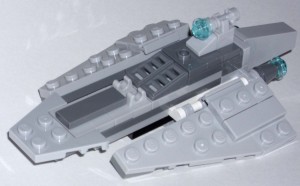The Lego Box Presentation Method is to put meaning before detail. When Lego sells a Starfighter the picture on the box show it fully assembled, not the 560 multi-colored pieces and a collegiate dictionary-size book of assembly directions.
The Lego Box Presentation Method
I respect your time so I will keep this short.
In two minutes I can explain why getting to the point immediately in a presentation or demo to an individual or small group is good for not only the survival but also the growth of your business. It’s the approach least likely to waste your time or theirs, and the most likely to start a serious conversation that can form the basis for a new business relationship.
If you communicate the key points first your audience is much better equipped to process the details: this means that they are more likely to understand you, believe you, and do business with you.
This matches the way the brain works. In “Brain Rules” author John Medina, a developmental molecular biologist, cites cognitive research results that demonstrate that the brain processes meaning before details. He advises:
“Don’t start with the details. Start with the key ideas, and in a hierarchical fashion, form the details around these larger notions.”
What are two key points to communicate?
- First, that you will repay a few minutes of their attention with information that is relevant to their situation and actionable.
- Second, how your offering will help them address a critical business issue–and result in more revenue, more profit, or reduced risk.
If you present the meaning first, you will naturally adopt the other person’s point of view and you will be much less likely to overwhelm them because you are presenting your ideas in a way that is most easily processed.
Why is this hard to do? Because we like to save the best for last.
Whether it’s the punch line to a joke or the identity of the killer in a whodunit, we like to withhold the key piece of information that organizes and make sense of everything else that has been said.
But this is a match to the wrong presentation format for the story you want to tell.
Instead think about the Lego box photo, the first thing that you see on a store shelf or on Amazon.com. Lego has a well-known brand name, founded in 1932 and still privately held, it has produced more than 400 billion toy bricks.
 The company puts the most important information first on the box. A photo of the Lego Star Wars x-Wing Starfighter provides a clear context to the prospective parent buyer or a child who is building a birthday wish list.
The company puts the most important information first on the box. A photo of the Lego Star Wars x-Wing Starfighter provides a clear context to the prospective parent buyer or a child who is building a birthday wish list.
The first thing you see after you open the Starfighter box is 560 multi-colored pieces and a collegiate dictionary-size book of assembly directions. It’s obvious why the company does not put these images on the box.
Two final examples.
- A cooking show will start with a shot of the final dish, for example barbecue spare ribs for your next cookout. Because we eat with our eyes first, this may entice you to continue watching to learn how to prepare the ribs.
- A newspaper prints headlines in large type, and the gist of the story in the first sentence, so that you can decide whether or not to read the whole article.
Why should your presentation be any different?
Related Blog Posts
- Ten Tips For New Product Demos
- A Great Demo Is A Conversation Driven By Mutual Curiosity
- Recap of “How To Give a Great Demo” at CoFounders Club Wed-Apr-16-2014
- Great Demo Workshop Attendee: “Holy Crap! My Demos Have Too Much Detail”



Pingback: SKMurphy, Inc. » Quotes For Entrepreneurs–August 2013